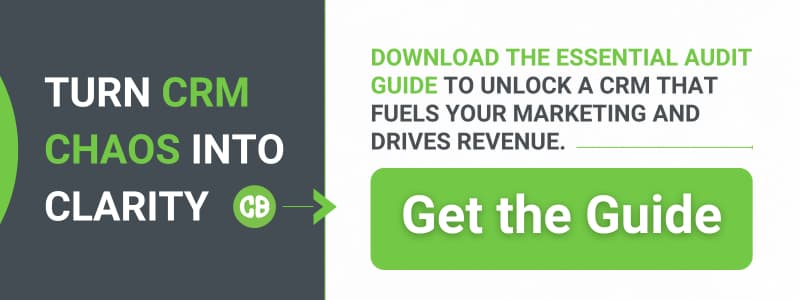A dirty CRM costs you leads, trust, and revenue. This step-by-step guide shows you how to clean it up, keep it clean, and make it work like it should.
If your CRM feels more like a liability than an asset, you're not alone. Sales avoids it. Marketing doesn’t trust it. Leadership gets reports that feel more like fiction than facts.
What you're dealing with isn’t just a messy tool. It’s a revenue leak.
A disorganized CRM slows everything down. It leads to missed follow-ups, misaligned campaigns, and vague pipeline forecasts. But here’s the good news: you don’t need to overhaul your entire tech stack. You just need a smarter approach, and this guide will walk you through it.
In this article, you’ll learn:
- How to quickly spot the signs of CRM clutter
- A step-by-step cleanup process that won’t break your systems
- Habits that keep your CRM aligned with revenue goals
Whether you're in marketing, sales, or operations, this is your playbook for turning your CRM into a high-performing asset your team actually uses.
How to Spot CRM Clutter (And Why You Should Care)
Most CRMs aren’t working the way they should.
The data’s messy. The reports are unreliable. The team avoids using it unless they’re forced to.
It might have been set up with the best of intentions, but it became a digital junk drawer full of duplicates, half-finished records, and outdated contacts somewhere along the way.
This isn’t just an operational issue. It’s a revenue issue.
- Sales is chasing cold leads.
- Marketing campaigns are missing the mark.
- Leadership can’t trust what’s in the pipeline.
A CRM that’s cluttered, outdated, and untrusted slows everything down. But fixing it doesn’t mean starting from scratch. You don’t need a new platform. You need a better system and a commitment to keeping it clean.
Let’s walk through exactly how to do that.
Step 1: Diagnose the Mess
Start with a sample of your data. Don’t overthink it. Just pull up a batch of records at random. Here’s what to look for:
- Contacts missing critical fields (email, phone, title)
- Accounts untouched for over a year
- Sloppy formatting (inconsistent capitalization, fields used incorrectly)
- Duplicate or conflicting entries across teams
Get marketing and sales in the same room. Look at the data together. Patterns and problems will show up fast.
Step 2: Standardize Your Data
Now it’s time to set rules.
- Names: title case. No more “JOHN DOE” or “sally smith.”
- Phone numbers: formatted consistently.
- Job titles: pulled from an approved picklist.
- Addresses: complete and structured properly
Why it matters: Consistent data enables automation, accurate reporting, and smarter segmentation.
Clean inputs mean clean outputs.
Step 3: Eliminate Duplicates
Duplicates kill productivity and skew reporting. One record says “lead,” another says “customer,” and a third says nothing at all.
Use built-in tools from your CRM (HubSpot, Salesforce, Zoho) or third-party apps like Insycle or Dedupely. Merge what you can. Archive or delete what you can’t. Put safeguards in place to prevent this from happening again.
One person = one record. No exceptions.
Step 4: Clear Out Dead Weight
Take a hard look at your inactive records. If a contact hasn’t engaged in over a year and there's no strategic reason to keep them, then move them out.
Not ready to delete?
Tag them as “inactive” and run a final re-engagement campaign. Don’t let them clog your lists.
Prioritize the contacts that actually drive results.
Step 5: Optimize Your Workflows
Now that your data’s clean, it’s time to streamline how it’s used:
- Automate lead assignments.
- Set alerts for follow-ups.
- Trigger workflows at key lifecycle stages.
- Build dashboards that track performance by role or campaign.
This isn’t just cleanup. It’s transformation. Your CRM should power decisions and drive momentum, not sit idle as a digital filing cabinet.

Keep Your CRM Clean
You did the hard part. The audit, the purge, the deduplication. Your CRM is looking sharp. But if you don’t keep it clean, it’s only a matter of time before the clutter creeps back in.
CRM hygiene isn’t a one-time thing, it’s routine maintenance. Here’s how to keep your CRM from turning back into a dumpster fire.
1. Make Data Reviews Routine
Schedule quarterly reviews. Pull samples. Fix inconsistencies. Make it a recurring task, just like QBRs.
2. Train With Intention
Every new hire should get real CRM onboarding. Document the standards. Share short videos. Update training whenever fields or workflows change.
3. Set Up Validation Rules
If it matters, enforce it. Use your CRM’s validation settings to block junk data at the point of entry. Force standard formatting. Prevent blanks in key fields. Make quality control automatic.
4. Collect Feedback
Your sales and marketing teams know where the friction is. Ask them regularly: What’s not working? What’s confusing? What would make their lives easier? Then fix it.
Clean CRM, Better Results
A clean CRM is more than a tidy database. It’s the foundation for smarter marketing, stronger sales, and accurate reporting. When it’s organized and aligned, you get:
- Sales teams that trust the data
- Marketing campaigns that hit the right audience
- Reports that actually reflect reality
You’ve already invested in a CRM. It’s time to make it deliver.

.png?width=1000&name=CB%2025.4.2.4%20Featured%20V3%20(1).png)